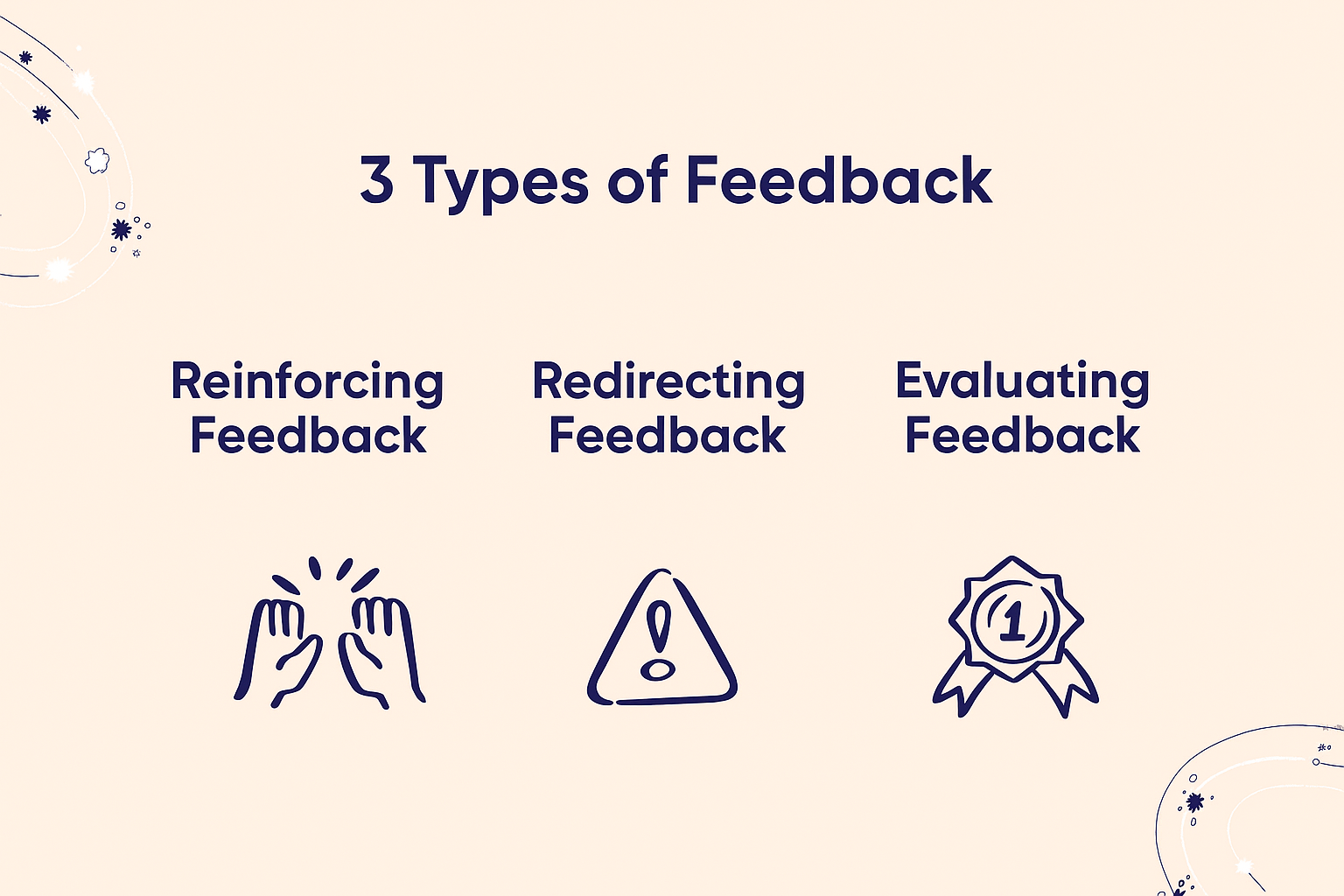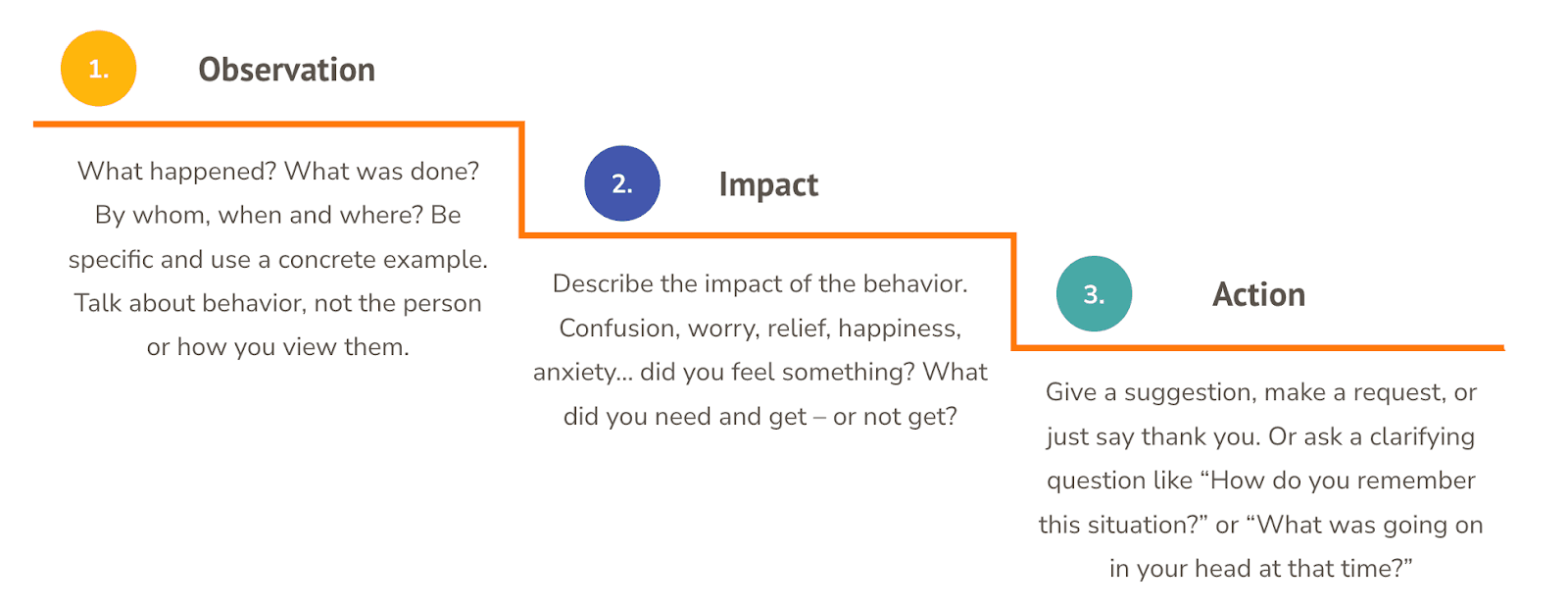60 Employee Feedback Examples That Actually Make a Difference
August 11, 2025Good feedback depends on both what you say AND how you say it. When you know how to say what’s on your mind, tough conversations can bring people closer and boost performance.
Giving feedback can be awkward. You know something needs to be said, but you’re worried it might hurt someone’s feelings or make things uncomfortable. So, you stay quiet and hope things will fix themselves. Spoiler alert: they won’t.
After spending ten years in leadership positions, I’ve learned one thing clearly: good feedback depends on both what you say AND how you say it. When you know how to say what’s on your mind, tough conversations can bring people closer and boost performance.
That’s why I’ve pulled together these 60 employee feedback examples. These are real phrases I’ve used or coached others to use. They’re clear, direct, and practical. No buzzwords. Just real language you can use right away to have better talks with your team.
Why Is Employee Feedback Important?
Employee feedback is when you give someone your thoughts on how they’re doing at work: what’s going well, what could improve, and how they can grow.
The data shows that people are actually starving for good feedback. Here’s why employee feedback matters:
- Drives Performance Improvement: Feedback helps employees know what they’re doing right and what they should change, so they keep getting better.
- Increases Employee Engagement: Teams that get regular feedback are nearly three times more likely to feel engaged at work, according to Gallup.
- Builds Trust and Relationships: Honest feedback creates open communication and stronger manager-employee bonds.
- Supports Employee Development: Helpful feedback shows employees where to grow and what skills to build next.
- Reduces Turnover: Employees who get feedback often are over three times more likely to stay in their job.
- Improves Team Collaboration: Feedback about how people work together helps teams run more smoothly.
Even though most employees want more feedback (65% say they don’t get enough), many managers still struggle with how to give it well. The examples below can help change that.
Listen to Your People
Track engagement and wellbeing continuously and ensure leaders take action on all levels of the organization – effortlessly in Slack or MS Teams.
Three Types of Employee Feedback: Reinforcing, Redirecting, and Evaluating
After building feedback programs for several companies, I’ve found that knowing these three types of feedback is key for every leader.

Reinforcing Feedback (Appreciation)
This is positive feedback that praises good behavior. It helps people know what to keep doing.
In my experience, most of your feedback should fall into this category. When people hear what they’re doing well, they feel motivated and loyal, and they keep working hard.
Redirecting Feedback (Coaching)
This type helps people improve by showing them a better way to do something.
To make redirecting feedback useful, stick to three points:
- What happened (the situation and behavior)
- What effect it had
- What should change next time
Evaluating Feedback (Assessment)
This kind of feedback compares someone’s performance to specific goals or standards. It’s helpful for performance reviews and pay decisions, but not for everyday conversations.
I’ve found that evaluation works best during formal reviews, not during daily coaching.
The Anatomy of an Effective Piece of Employee Feedback
After years of coaching managers and giving feedback, I’ve developed a simple but effective method: Observation, Impact, Action (OIA).

Start with Factual Observation
Start by saying exactly what you saw or heard, without judgment or opinion. Use clear, specific examples so the person knows what you mean.
Focus on what the person did, not on who they are.
Explain the Impact
Next, explain how their behavior affected you, the team, or the company. This shows why your feedback is important.
If you’re in a leadership role and others have raised concerns, it’s okay to speak on their behalf.
Request Specific Action
Finish with a clear request or suggestion. This gives the person a clear next step.
Be direct. Make your request specific, not vague or general.
Here’s an example:
Instead of: “You need to be more professional in meetings.”
Try:
“During yesterday’s client meeting, I noticed you answered your phone twice [observation]. This made it hard for us to stay focused and may have made the client feel the meeting wasn’t important [impact]. Could you please silence your phone and step out if you need to take urgent calls? [action]”
This way of giving feedback is respectful, clear, and helpful.
60 Employee Feedback Examples
Now that you know how to structure your feedback, let’s take a look at some examples. These ready-to-use examples are ones I’ve refined over the years. Each is specific, clear, and easy to act on.
20 Reinforcing Feedback Examples
These show how to praise helpful actions and encourage great habits. Positive feedback like this should be most of what you say to your team.
- “I saw you take the time to help the new intern learn our project system. Your patience made them feel welcome and confident.”
- “Your client presentation last week was excellent. You were well-prepared and handled questions like a pro.”
- “Thanks for stepping in to help Sarah with the budget. Your teamwork really helped us stay on track.”
- “The creative fix you used for the shipping delay saved us time and money. That kind of thinking stands out.”
- “Thanks for catching the error in our meeting. Your attention to detail saved us from a big mistake.”
- “You always meet your deadlines and still deliver great work. That makes planning easier for the rest of us.”
- “You handled that tough customer call really well. You stayed calm and solved the problem smoothly.”
- “Organizing the team lunch last month really lifted everyone’s mood. Thanks for making it happen.”
- “I see you’re mentoring Jake on the new software. Sharing your knowledge helps the whole team grow.”
- “Your meeting notes are super clear and helpful. They keep everyone on the same page.”
- “Your positive attitude has a real impact on team morale. It’s great to have your energy in the room.”
- “You’ve made great progress on your writing. The last report was clear and to the point.”
- “You took feedback from last week and really improved this time. That kind of growth is impressive.”
- “The way you run team stand-ups keeps everyone focused and on track.”
- “I noticed you volunteered to take the late shift. That kind of support doesn’t go unnoticed.”
- “You did a great job training the new hire. They’ve already mentioned how helpful you’ve been.”
- “Your clear communication on Slack helps avoid confusion. Keep it up.”
- “Thanks for keeping the project organized. The checklist you created made everything run smoother.”
- “Your creative ideas in last week’s brainstorming session sparked some great new thinking.”
- “You’ve really grown your confidence in meetings lately. I’ve noticed—and so have others.”
20 Redirecting Feedback Examples
Use these when someone needs to shift a behavior or improve a skill. Keep it supportive and focused on the future.
- “I noticed you spoke over Jane in the meeting. Let’s work on giving everyone space to share their ideas.”
- “The client email had a few grammar issues. I’d suggest slowing down to proofread next time.”
- “I saw the report was late. What can we adjust to make sure deadlines are met moving forward?”
- “During presentations, try to speak a bit slower. It’ll help the team follow your message better.”
- “You’ve missed a few daily stand-ups. Can we talk about what’s making that hard to attend?”
- “It’s important to loop me in earlier on big decisions. That way we avoid last-minute changes.”
- “I noticed the project plan was missing a timeline. Let’s make sure we include key dates from now on.”
- “Interrupting others can make them feel dismissed. Let’s work on letting people finish their thoughts.”
- “Let’s find a way to share your workload better so that urgent tasks don’t slip through.”
- “Your responses in emails sometimes come across as too blunt. Let’s work on adding a bit more context.”
- “You’ve been late to a few meetings. Let’s talk about what might help you be on time.”
- “There’s been some tension in how feedback was delivered. Let’s explore more constructive language.”
- “I noticed some resistance during the policy update. Let’s talk about your concerns and how we can align.”
- “The report lacked some key data. Next time, check the template to make sure everything’s included.”
- “I appreciate your independence, but remember to check in so we stay aligned.”
- “Your energy is great, but let’s be mindful of talking over quieter voices in group settings.”
- “The team needs clearer updates on your progress. Could you share weekly check-ins going forward?”
- “You’ve had some great ideas—just remember to back them up with data when pitching them.”
- “You seem distracted in meetings. Anything going on? Let’s chat about how to keep you engaged.”
- “Let’s work on how we respond to feedback—curiosity over defensiveness can help us all grow.”
20 Evaluating Feedback Examples
These help people understand how they’re doing in a more formal way. Use this kind of feedback during employee reviews or career development talks.
- “You’ve consistently met your performance goals for three quarters in a row — great work.”
- “Your sales results are below target. Let’s build a plan to improve this quarter.”
- “You’re meeting expectations in most areas, and exceeding them in team collaboration.”
- “We set a goal to increase outreach emails by 20%, and you delivered 25%. Excellent work.”
- “You’ve grown a lot in this role, especially in how you lead meetings and manage your time.”
- “You’re not yet meeting the expectations for this role. Let’s talk about where the gaps are.”
- “Compared to peers, your performance on cross-team projects stands out as especially strong.”
- “We’ve had some consistent feedback about communication delays. Let’s address that.”
- “Your technical skills are strong, and I’d like to see you grow your leadership presence next.”
- “You’ve made big strides in client satisfaction scores, which shows your focus is paying off.”
- “This quarter, you’ve handled a higher volume of work with consistent quality.”
- “You’re on track for promotion if progress continues in this direction.”
- “Based on this year’s review, we’re recommending a salary increase.”
- “Your goals for the quarter weren’t met. Let’s reset and build more support this time.”
- “Your work ethic is clear, but there’s still room for development in strategic thinking.”
- “You’ve grown your impact in the org through the mentorship program and cross-functional work.”
- “This year’s results were solid overall. Let’s set a stretch goal for next year.”
- “You’ve outperformed the team average in three out of four KPIs.”
- “Let’s work on growing your confidence presenting to senior leaders.”
- “Your performance is strong, and I’d like to talk about next steps in your career path.”
Final Thoughts
Giving feedback is a skill, not a talent. The more you do it, the better you get.
If you’re a manager, use these examples to bring more clarity and support to your conversations. Your team wants to hear how they’re doing. They just need you to speak up.
If you’re building a feedback culture, start here. Share these phrases with other leaders. Use them in your next 1-on-1. Add them to your performance review toolkit.
Good feedback is how good teams get even better.
Want to learn more about different feedback tools? Check out our review of feedback software tools!



